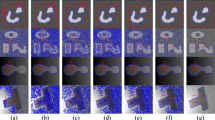Abstract
For segmenting medical images with abundant noise, blurry boundaries, and intensity heterogeneities effectively, a hybrid active contour model that synthesizes the global information and the local information is proposed. A novel global energy functional is constructed, together with an adaptive weight by the statistical information of image pixels on the clustering idea. Minimizing this global energy functional in a variational level set formulation will drive the curve to desirable boundaries. The local energy functional contains the local threshold, which is used to correct the deviation of the level set function. Experiments demonstrate that the proposed method can segment synthetic and medical images effectively, and have a relatively higher performance compared to other representative methods.








Similar content being viewed by others
References
Ali, H., Badshah, N., Chen, K., & Khan, G. (2016). A variational model with hybrid images data fitting energies for segmentation of images with intensity inhomogeneity. Pattern Recognition, 51, 27–42.
Chan, T., & Vese, L. (2001). Active contour without edges. IEEE Transactions on Image Processing, 10(2), 266–277.
Fang, L. L., Zhao, W. T., Li, X. Y., & Wang, X. H. (2017). A convex active contour model driven by local entropy energy with applications to infrared ship target segmentation. Optics Laser Technology, 96, 166–175.
Feinberg, E. A., Kasyanov, P. O., & Zadoianchuk, N. V. (2014). Fatou’s lemma for weakly converging probabilities. Theory of Probability & Its Applications, 58(4), 683–689.
Gloger, O., Tönnies, K., Bülow, R., & Voelzke, H. (2017). Automatized spleen segmentation in non-contrast-enhanced MR volume data using subject-specific shape priors. Physics in Medicine & Biology, 62(14), 5861–5883.
Hald, A. H. (2015). The truncated normal distribution. In Statistics for research (3rd ed., p. 661). John Wiley & Sons Inc. 2005.
Jayadevappa, D., Kumar, S., & Murty, D. (2011). Medical image segmentation algorithms using deformable models: A review. IETE Technical Review, 28(3), 248–255.
Lankton, S., & Tannenbaum, A. (2008). Localizing region-based active contours. IEEE Transactions on Image Processing, 17(11), 2029–2039.
Li, C., Kao, C., Gore, J., & Ding, Z. (2008). Minimization of region-scalable fitting energy for image segmentation. IEEE Transactions on Image Processing, 17(10), 1940–1949.
Li, C., Wang, X., Eberl, S., Fulham, M., & Feng, D. (2013a). Robust model for segmenting images with/without intensity inhomogeneities. IEEE Transactions on Image Processing, 22(8), 3296–3309.
Li, C., Wang, X., Eberl, S., Fulham, M., Yin, Y., Chen, J., et al. (2013b). A likelihood and local constraint level set model for liver tumor segmentation from CT volumes. IEEE Transactions on Biomedical Engineering, 60(10), 2967–2977.
Liu, J., Wu, Q. J., Kirkpatrick, J. P., Yin, F. F., Yuan, L., & Ge, Y. (2015). From active shape model to active optical, flow model: A shape-based approach to, predicting voxel-level dose distributions in, spine SBRT. Physics in Medicine & Biology, 60(5), 83–92.
Mabood, L., Ali, H., Badshah, N., & Ullah, T. (2015). Absolute median deviation based a robust image segmentation model. Journal of Information and Communication Technology, 9(1), 13–22.
Mylona, E., Savelonas, M., & Maroulis, D. (2014). Automated adjustment of region-based active contour parameters using local image geometry. IEEE Transactions on Cybernetics, 44(12), 2757–2770.
Nezza, E. D., Palatucci, G., & Valdinoci, E. (2011). Hitchhikerʼs guide to the fractional Sobolev spaces. Bulletin Des Sciences Mathématiques, 136(5), 521–573.
Patel, S., Garasia, S., Jinwala, D. (2017). An efficient approach for privacy preserving distributed K-means clustering based on shamir’s secret sharing scheme. In Trust management VI 2017 (pp. 129–141).
Wang, L., Chang, Y., Wang, H., Wu, Z., Pu, J. T., & Yang, X. D. (2017). An active contour model based on local fitted images for image segmentation. Information Sciences, 418–419, 61–73.
Wang, B., Gao, X., Tao, D., & Li, X. (2014a). A nonlinear adaptive level set for image segmentation. IEEE Transactions on Cybernetics, 44(3), 418–428.
Wang, H., & Liu, M. (2013). Active contours driven by local gaussian distribution fitting energy based on local entropy. International Journal of Pattern Recognition and Artificial Intelligence, 27(6), 1073–1089.
Wang, L., Shi, F., Li, G., Gao, Y., Lin, W., Gilmore, J., et al. (2014b). Segmentation of neonatal brain mr images using patch-driven level sets. NeuroImage, 84(1), 141–158.
Yang, X., Gao, X., Li, J., & Han, B. (2014). A shape-initialized and intensity-adaptive level set method for auroral oval segmentation. Information Sciences, 277(2), 794–807.
Zhang, L., & Zhang, D. (2016). Visual understanding via multi-feature shared learning with global consistency. IEEE Transactions on Multimedia, 18(2), 247–259.
Zhang, K. H., & Zhou, W. G. (2008). An improved CV active contour model. Optoelectronic Components, 35(12), 112–116.
Zhang, L., Zuo, W., & Zhang, D. (2016). LSDT: Latent sparse domain transfer learning for visual adaptation. IEEE Transactions on Image Processing, 25(3), 1177–1191.
Zhao, Y., Rada, L., Chen, K., Harding, S., & Zheng, Y. (2015). Automated vessel segmentation using infinite perimeter active contour model with hybrid region information with application to retinal images. IEEE Transactions on Medical Imaging, 34(9), 1797–1807.
Acknowledgements
This work was supported by China Postdoctoral Science Foundation under Grant 2017M621130, Liaoning Provincial Natural Science Fund Guidance Plan under Grant 201602228, Natural Science Foundations of China under Grant 61172108, 61139001, 81241059, 61671105, and 41671439.
Author information
Authors and Affiliations
Corresponding author
Ethics declarations
Conflict of interest
The authors declare that they have no conflict of interest.
Rights and permissions
About this article
Cite this article
Fang, L., Qiu, T., Zhao, H. et al. A hybrid active contour model based on global and local information for medical image segmentation. Multidim Syst Sign Process 30, 689–703 (2019). https://doi.org/10.1007/s11045-018-0578-0
Received:
Revised:
Accepted:
Published:
Issue Date:
DOI: https://doi.org/10.1007/s11045-018-0578-0




